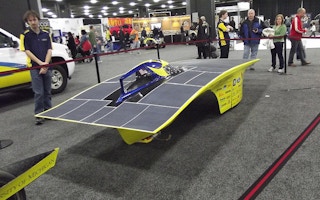In another move towards the development of what is called “mobile energy,” Hanergy unveiled four purely solar-powered vehicles on July 2 at its headquarters in Beijing. Hanergy named the four prototype cars Solar O, Solar L, Solar A and a racing car type Solar R. Each car will target a different market.
Unlike almost all purely electric cars in the market, Hanergy solar cars do not need regular plug-in charging since the thin-film GaAs double-junction solar cells on the cars’ surfaces will convert PV power to electricity.
Acquiring power directly from the sun gives Hanergy solar car users greater liberty since they do not depend on charging posts, which are normally scarce in places away from city centres or residential communities. In other words, users no longer have to bother with “distance per charge,” since “zero charging” and “infinite mileage” becomes possible for medium-and-short distance trips.
“With five to six hours of sunlight, the thin-film solar cells on the vehicle are able to generate eight to ten kilowatt-hours of power a day, allowing it to travel about 80 kilometers – equivalent to over 20,000 KM annually – which satisfies normal driving needs in a city,” said Dr. Gao Weimin, Hanergy’s vice president and CEO of the solar vehicle division.
Although it will still be some time before the prototypes hit the market, the launch of purely solar-powered vehicles showed Hanergy’s determination to carry on with its “mobile energy” concept.
In his keynote speech at the product launch ceremony, Hanergy founder and chairman Li Hejun spoke about the advantages of thin-film solar cells, such as their light weight and flexibility of use, enabling the cells to be integrated into a variety of products such as cars, unmanned aerial vehicles, mobiles, backpacks and clothes.
“
With five to six hours of sunlight, the thin-film solar cells on the vehicle are able to generate eight to ten kilowatt-hours of power a day, allowing it to travel about 80 kilometers – equivalent to over 20,000 KM annually – which satisfies normal driving needs in a city.
Gao Weimin, president and CEO, solar energy vehicle division, Hanergy
He said the four new wholly solar-powered vehicles showcase the latest achievements in Hanergy’s mobile energy strategy, something Hanergy persisted in despite “unprecedented difficulty in the company last year.”
Last May, Hanergy Holding’s Hong Kong-listed company Hanergy Thin-Film Power suffered a drastic stock plunge, which vaporised about half of Li’s fortune and triggered the Hong Kong stock regulator’s decision to suspend its trading.
Currently, Hanergy Thin-Film Power (HK. 00566) is still seeking to resume HKEx trading and Li has quit the direct management of Hanergy’s Hong Kong subsidiary to focus more on the group company and its overall strategies.
This story is published with permission from China.org.cn










